Gourmet Chocolates – How to Make the Luscious Center
Is making hand-made, gourmet chocolates your idea of a dream job? Guess what – it IS fun to work in a chocolate factory!
On the first day, a new employee will stop at the door and just breathe deeply. The factory smells so wonderful! Chocolate smells ooze from every corner of the kitchen. However, by the end of the week, the new employee will not stop at the door and take a deep breath. Why? Because they can no longer smell the chocolate! That’s right. Even a wonderful smell like warm gourmet chocolate is unnoticed by the brain when a person works in a chocolate factory every day. It is a good thing we don’t depend upon smell alone to keep us coming back to the factory.
No, the real fun is in the hand-making of the confectionary. For example, here is what a cook at a Gilbert Chocolates factory might do:
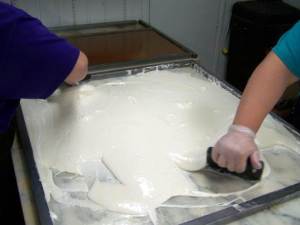 If it is a day when we are making the cream centers for our Gilbert Chocolates, her day will start out measuring ingredients and putting them in a large kettle to cook on the stove. The ingredients must rise to a specified temperature and then the contents of the kettle are poured onto a marble slab where more ingredients are added and mixed in with bench scrapers while the mixture slowly cools.
If it is a day when we are making the cream centers for our Gilbert Chocolates, her day will start out measuring ingredients and putting them in a large kettle to cook on the stove. The ingredients must rise to a specified temperature and then the contents of the kettle are poured onto a marble slab where more ingredients are added and mixed in with bench scrapers while the mixture slowly cools.
After the mixture has cooled enough to work with it by hand, the cook flours the surface of the marble table and divides the mixture into different balls of dough that she kneads for a couple of reasons, first to help the dough cool faster and also to reach a smooth consistency.
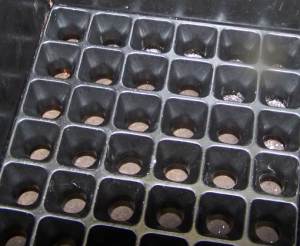 After the cream centers are sufficiently kneaded and cooled, the dough is then placed in what we call a “center press”. We also call it “The Friend” because the center press that we use at Gilbert Chocolates is probably close to 100 years old and was manufactured by a company named Friend. It still does a great job of making evenly-sized centers for our chocolates. Essentially, our “Friend” pushes the candy centers through a mold that makes the centers.
After the cream centers are sufficiently kneaded and cooled, the dough is then placed in what we call a “center press”. We also call it “The Friend” because the center press that we use at Gilbert Chocolates is probably close to 100 years old and was manufactured by a company named Friend. It still does a great job of making evenly-sized centers for our chocolates. Essentially, our “Friend” pushes the candy centers through a mold that makes the centers.
The candy centers then rest on the rack until we are ready to enrobe them. This resting time gives them the stiffness they need to handle the enrobing process.
The enrobing machine covers the centers in warm tempered chocolate – it looks like a chocolate waterfall covering the candy.
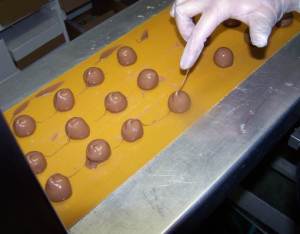 After being enrobed, the chocolatier hand marks each piece of chocolate with a letter or symbol so that everyone knows what flavor of center is inside the chocolate. The conveyor belt then moves the candy immediately into the air conditioned portion of the enrobing machine.
After being enrobed, the chocolatier hand marks each piece of chocolate with a letter or symbol so that everyone knows what flavor of center is inside the chocolate. The conveyor belt then moves the candy immediately into the air conditioned portion of the enrobing machine.
This portion of the enrober is actually the largest part of the enrobing line. The temperature at the beginning of the tunnel is cooler than the temperature at the end and the candy moves at a sedate speed. This ensures that the candy cools slowly enough to prevent the chocolate from “blooming” later on.
Finally, it all results in delicious, beautiful, gourmet chocolate that you can purchase from our store at the Jackson Crossings Mall or at the Meridian Mall or even from our factory or website! As you can now appreciate, hand-making gourmet chocolates is a rather exacting process that requires skill and craftsmanship that we have mastered here at Gilbert Chocolates.
Tempered Chocolate Reduces Gourmet Chocolate Bloom
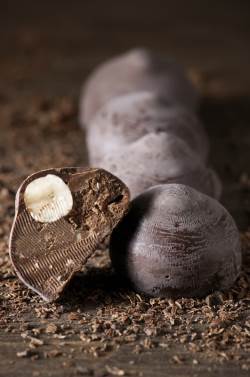 Quality is important when buying gourmet chocolates online, and the preparation methods must be consistent and precise in order to prevent chocolate bloom and produce a delectable treat that withstands shipping from the factory to the final destination.
Quality is important when buying gourmet chocolates online, and the preparation methods must be consistent and precise in order to prevent chocolate bloom and produce a delectable treat that withstands shipping from the factory to the final destination.
Is it good when chocolate blooms?
For the true chocolatier, the short answer is NO! While a blooming piece of chocolate is perfectly safe to eat, it doesn’t look as nice and its texture may not be perfect.
So what exactly is a blooming chocolate?
Chocolate has “bloomed” when the surface of the chocolate develops a white film and loses it shine. There are a couple of theories for exactly what is causing the blooming, and here is one of them:
Chocolate has triglycerides (the fat properties one finds in things like vegetable oils, animal fats, etc.) that we call cocoa butter. A “fat bloom” occurs when the cocoa butter in the chocolate separates from the rest of the chocolate and rises to the surface, creating a greasy or streaky appearance.
Why does fat bloom occur?
The process of making a chocolate bar is actually complicated. Chocolate must be tempered, which is a process of repeatedly raising and lowering the chocolate’s temperature to exact measurements before it is ready to be made into candy. The tempering creates uniform, stable crystals of cocoa butter. When everything is done correctly, the end result is that all the differently sized cocoa butter crystals will be stable and not break down into “a fat bloom”. Done incorrectly…and well the product doesn’t look as nice.
Fat bloom can occur in other ways besides the tempering process, such as if the chocolate maker doesn’t allow the candy to cool before packaging it. Or, in the case of less expensive chocolate, if a cocoa butter substitute is used, it may not follow the same recipe for tempering and thus create fat bloom.
Or a third way fat bloom may be created is if the chocolate is used to cover a cold filling or nuts that contain fat. This again can cause the chocolate cocoa crystals to become unstable and create fat bloom.
Fat bloom caused by pairing the chocolate with nuts may be slowed down if chocolate makers add a tiny amount of an “antibloom fat” such as palm oil. Palm oil is also used as an emulsifier in other foods, too.
Chocolatiers work very hard to create chocolate candy that will not bloom! Who knew?
Three Reasons to Enjoy a Daily Dose of Dark Chocolate
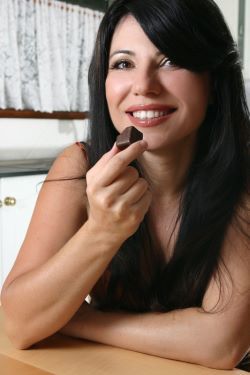 Indulging in chocolate might seem like a guilty pleasure, but it can actually be part of a healthy diet. Dark chocolate offers several health benefits, ranging from improved mood to a healthier heart. Recent studies have shown that it might even help diabetics control their blood sugar levels. So, skip the guilt, and enjoy a little of this tasty treat each day.
Indulging in chocolate might seem like a guilty pleasure, but it can actually be part of a healthy diet. Dark chocolate offers several health benefits, ranging from improved mood to a healthier heart. Recent studies have shown that it might even help diabetics control their blood sugar levels. So, skip the guilt, and enjoy a little of this tasty treat each day.
Boost Your Brain Power and Mood
Dark chocolate affects your brain in quite a few positive ways. Thanks to the chemical it contains, called phenylethylamine, it can serve as an instant mood boost. When you eat chocolate, this chemical helps your brain release endorphins, or “feel good” hormones. This type of chocolate also helps blood flow to your brain, which can help you stay alert, focus better and think more clearly. It might even lower your risk of stroke.
Have a Healthy Heart
The cocoa beans that dark chocolate is made from contain antioxidants known as flavanols. These are substances that help reduce cell damage done by molecules called free radicals, which have been linked to heart disease. Flavanols in chocolate can help lower your risk of heart disease, improve blood flow to your heart and reduce your blood pressure. Eating a small amount of this chocolate each day or a moderate amount per week can help you keep your heart in good shape.
Lower Your Diabetes Risk
The number of people diagnosed with type 2 diabetes has been increasing over the past several years. If this disease runs in your family or if you have other risk factors for it, taking steps to lower your risk is crucial. Eating dark chocolate might help prevent you from developing diabetes due to the antioxidant properties it contains. These substances have been linked to better insulin sensitivity, which helps keep blood sugar levels under control.
Although dark chocolate is good for you, some products contain sugar and fat, so aim to have no more than three ounces per day. Moderation in all things is a good rule to apply here, but enjoy every savory bite of your dark chocolate!
